Photo Credit: Northwestern University
Tom O’Halloran is a chemist and world-renowned expert on inorganic compounds who believes that there are specific inorganic elements and compounds that we could use more broadly to kill cancer, one of which is arsenic:
“Arsenic is known more for its use as a poison than as a cancer drug. Arsenic poisoning is said to have killed Napoleon Bonaparte and Simon Bolivar. And paradoxically, arsenic exposure is associated with an increased risk of cancer.
Yet low doses of arsenic trioxide have shown a 95 percent remission rate in acute promyelocytic leukemia (APL), a type of blood cancer. Arsenic can shut down the growth of other cancers as well, O’Halloran says, but conventional arsenic delivery methods have not been successful in solid tumors in the breast, lung, ovaries and elsewhere.”1
And so, O’Halloran and his team put insoluble particles of the element into a liposome (a tiny droplet of fat about one-hundredth the width of a human hair) which created what they called a “nanobin.” These nanobins, when injected into the bloodstream, only release arsenic once they reach cancer cells and amazingly leave the healthy cells unscathed. How? It’s all thanks to a tumor’s biology:
“Cancer cells need to recruit a source of oxygen and nutrients in order to survive and grow. Through a process called angiogenesis, tumors send out signals that stimulate blood vessels to grow toward, in and around the tumor. Those new vessels, unlike others throughout the body, are leaky, with gaps and holes several hundred nanometers in diameter. These new vessels don’t leak red blood cells, which are too big to move through nanometer-sized holes, but nanobins can slip through the gaps to collect in the tumor.”2
Once through the cracks, the tumors start to collect the nanobins in ways that normal tissues don’t. In fact, the concentration of these arsenic-loaded liposomes builds up in the tumor. Because of the way cancer cells “process nutrients and make energy,” ( they are slightly more acidic than normal cells)3 that acid actually helps “dissolve the arsenic particles inside the nanobins, releasing the active drug inside the tumor.”4
RELATED STORY:
It seems O’Halloran has found a way to exploit the unique features of tumors in order to destroy them.
“Working in collaboration with the Robert H. Lurie Comprehensive Cancer Center of Northwestern University, O’Halloran’s team has shown in animal models that nanobin injections effectively kill breast, ovarian and lung cancer cells. O’Halloran and his collaborator Teresa K. Woodruff, chief of reproductive biology research at the Feinberg School of Medicine, showed that unlike other drug regimens, nanobin treatment is “ferto-protective,” preserving fertility while killing cancer.”5
RELATED STORY:
For those who still choose to use drugs to fight their cancer, it’s clear that new treatments are needed. Perhaps this is the future.












